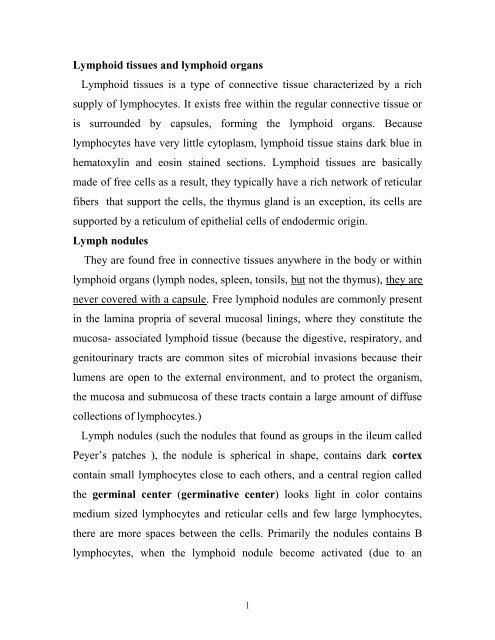lymphoid nodules
lymphoid nodules
lymphoid nodules
You also want an ePaper? Increase the reach of your titles
YUMPU automatically turns print PDFs into web optimized ePapers that Google loves.
Lymphoid tissues and <strong>lymphoid</strong> organs<br />
Lymphoid tissues is a type of connective tissue characterized by a rich<br />
supply of lymphocytes. It exists free within the regular connective tissue or<br />
is surrounded by capsules, forming the <strong>lymphoid</strong> organs. Because<br />
lymphocytes have very little cytoplasm, <strong>lymphoid</strong> tissue stains dark blue in<br />
hematoxylin and eosin stained sections. Lymphoid tissues are basically<br />
made of free cells as a result, they typically have a rich network of reticular<br />
fibers that support the cells, the thymus gland is an exception, its cells are<br />
supported by a reticulum of epithelial cells of endodermic origin.<br />
Lymph <strong>nodules</strong><br />
They are found free in connective tissues anywhere in the body or within<br />
<strong>lymphoid</strong> organs (lymph nodes, spleen, tonsils, but not the thymus), they are<br />
never covered with a capsule. Free <strong>lymphoid</strong> <strong>nodules</strong> are commonly present<br />
in the lamina propria of several mucosal linings, where they constitute the<br />
mucosa- associated <strong>lymphoid</strong> tissue (because the digestive, respiratory, and<br />
genitourinary tracts are common sites of microbial invasions because their<br />
lumens are open to the external environment, and to protect the organism,<br />
the mucosa and submucosa of these tracts contain a large amount of diffuse<br />
collections of lymphocytes.)<br />
Lymph <strong>nodules</strong> (such the <strong>nodules</strong> that found as groups in the ileum called<br />
Peyer’s patches ), the nodule is spherical in shape, contains dark cortex<br />
contain small lymphocytes close to each others, and a central region called<br />
the germinal center (germinative center) looks light in color contains<br />
medium sized lymphocytes and reticular cells and few large lymphocytes,<br />
there are more spaces between the cells. Primarily the <strong>nodules</strong> contains B<br />
lymphocytes, when the <strong>lymphoid</strong> nodule become activated (due to an<br />
1
infection) the lymphocytes proliferate in the central portion (the germinative<br />
center).<br />
Lymph node<br />
The lymph node has oval or bean shape, has a convex surface and the<br />
other surface with little concave called the hilum or hilus. The blood vessels<br />
enter and out from the node through the hilus, the afferent lymphatic vessels<br />
enter the node from the convex surface, and out from the hilus as efferent<br />
lymphatic vessels.<br />
Lymph node covered with capsule composed of connective tissue contains<br />
few smooth muscle cells, trabeculae (or septa)extend from the capsule inside<br />
the node. The node composed of two regions, the outer is the cortex and the<br />
inner is the medulla.<br />
The cortex characterized by the presence of the lymph <strong>nodules</strong> composed<br />
of dense <strong>lymphoid</strong> tissue and contain germinative centers. The space<br />
between the capsule and the <strong>nodules</strong> called subcapsular sinus. The spaces<br />
between trabecula and the <strong>nodules</strong> called cortical sinuses, the sinuses<br />
composed of reticular connective tissue.<br />
The <strong>lymphoid</strong> tissue of the medulla composed of cords called medullary<br />
cords separated from the medullary trabeculae by medullary sinuses which<br />
connect with the corticular sinuses.<br />
The Thymus<br />
The thymus surrounded by capsule composed of connective tissue with<br />
trabeculae divide the thymus gland into lobules, each lobule consists of dark<br />
cortex has dense <strong>lymphoid</strong> tissue and a light medulla composed of loose<br />
<strong>lymphoid</strong> tissue, in addition to T lymphocytes the medulla contains several<br />
oval or spherical corpuscles called thymic corpuscles or Hassall corpuscles,<br />
2
which contain flattened epithelial reticular cells that are arranged<br />
concentrically and are filled with keratin filaments.<br />
The Spleen<br />
This organ covered with a capsule composed of dense connective tissue<br />
contain few smooth muscle cells, the capsule has trabeculae extends inside<br />
the organ and divide it into lobules, the spaces between trabeculae filled with<br />
connective tissue called splenic pulps, which found in two types:<br />
White pulp: which surrounded the arteries that enter the spleen, and splenic<br />
<strong>nodules</strong>, each splenic nodule contains many germinative center and a central<br />
artery (although its name this artery is eccentric in the nodule).<br />
The <strong>nodules</strong> of white pulp surrounded by marginal zone consisting of many<br />
blood sinuses and loose <strong>lymphoid</strong> tissue contain few lymphocyte but many<br />
active macrophages), this zone contains a bundance of blood antigens and<br />
plays a major role in the immunological activities of the spleen.<br />
Red pulp: fills the spaces between the trabeculae and white pulps, it is<br />
looser than the white pulps, contain many venous sinuses. This pulp formed<br />
as loose cords called splenic cords or cords of Billroth, these cords contain a<br />
network of reticular cells supported by reticular fibers. The splenic cords<br />
contain T and B lymphocytes, macrophages, plasma cells, and many blood<br />
cells (erythrocytes, platelets, and granulocytes).<br />
The Tonsils<br />
Tonsils belong to the mucosa-associated <strong>lymphoid</strong> tissues, but, because<br />
they are incompletely encapsulated, they are considered as <strong>lymphoid</strong> organs.<br />
They constitute a <strong>lymphoid</strong> tissue that lies beneath and in contact with the<br />
epithelium of the initial portion of the digestive tract. They are palatine,<br />
pharangeal, and lingual tonsils.<br />
3
Two palatine tonsils are located in the lateral walls of the oral part of the<br />
pharynx. They lined with squamous strastified epithelium.<br />
The <strong>lymphoid</strong> tissue of these tonsils form a band that contains free<br />
lymphocytes and <strong>lymphoid</strong> <strong>nodules</strong> generally with germinative centers. Each<br />
tonsil has 10-20 epithelial invaginations that penetrate the tonsil deeply,<br />
forming crypt, whose lumens contain desquamated epithelial cells, live and<br />
dead lymphocytes, bacteria. Crypts may appear as purulent spots in<br />
tonsillitis.<br />
A band of dense connective tissue separating the <strong>lymphoid</strong> tissue from<br />
subjacent structures, this band called the capsule of the tonsil. This capsule<br />
usually acts as a barriers against spreading infections.<br />
4






